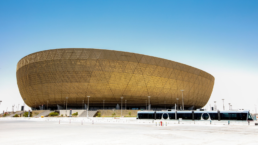A new report says stadium construction is largely to blame.
By Jessie Blaeser, Grist
The opening game of the 2022 FIFA World Cup is just days away, and all eyes are on host country Qatar, which has been getting ready to host the international soccer tournament since 2010. The preparations for the event, which organizers pledged would be “carbon-neutral,” have stirred up a significant amount of criticism related to worker exploitation and alleged human rights violations. Now, a climate watchdog group says the tournament’s organizers, which include representatives from FIFA and the Qatar government, misled the public by undercounting carbon emissions in one key area: stadiums.

Qatar has been on a decade-long World Cup construction boom, building seven new stadiums, 30 practice facilities, thousands of hotel rooms, and an expansion to the Doha International Airport.
Back when Qatar was awarded hosting privileges for the tournament, the event’s organizers pledged to offset all unavoidable emissions, largely through carbon credits. But achieving this “carbon-neutral” goal depends on a comprehensive accounting of all emissions associated with the World Cup, something researchers at the group Carbon Market Watch say FIFA and Qatar have failed to do.
“The main issue we found was with the construction of the stadiums,” said Gilles Dufrasne, policy officer for Carbon Market Watch and the author of the report, which was updated last month. He raised concerns about the placement of the stadiums and how they might be used in the future – two factors he says organizers did not sufficiently take into account in their carbon footprint calculations for this year’s tournament.
Already one of the hottest countries on Earth, Qatar faces worsening heat waves and water shortages as climate change intensifies. FIFA predicts activities related to this year’s World Cup will amount to 3.6 million metric tons of carbon dioxide, the equivalent of nearly 460,000 homes’ energy use for a year. According to FIFA’s latest emissions report, the largest sources of tournament-related emissions come down to air travel and accommodations, as more than 1.2 million fans are expected to attend the event from all over the world.
Stadium construction, meanwhile, accounts for roughly 18 percent of the group’s carbon estimations. In its report, tournament organizers calculated stadium emissions by splitting them between two different categories: temporary and permanent seats. Of the seven new stadiums built for the Qatar tournament, World Cup organizers plan to dismantle one entirely and reduce the capacity of the others by nearly half.
Recent Posts
“The Blue Road To Trump Hell”: Norm Solomon On “How Corporate Democrats Paved The Way For Autocracy”
December 31, 2025
Take Action Now “If you don’t examine real history, then you’re in a cycle that repeats the same problems,” says Norman Solomon, director of…
Why is the Democratic party hiding its 2024 autopsy report?
December 30, 2025
Take Action Now If the DNC isn’t open and transparent about why they lost, then how can we be sure they will learn their lesson this time?By…
Anti-ICE Resistance Sprang Up Across Red States In 2025
December 29, 2025
Take Action Now In Texas, North Carolina, Alabama, Tennessee, Florida, and beyond, grassroots resistance to ICE is growing.By Sonali Kolhatkar,…
Trump Suggests US Bombed ‘Big Facility’ in Venezuela. No One Seems to Know What He’s Talking About
December 29, 2025
Take Action Now Administration officials have yet to provide any details about the supposed strike, which would mark a massive escalation in the…




